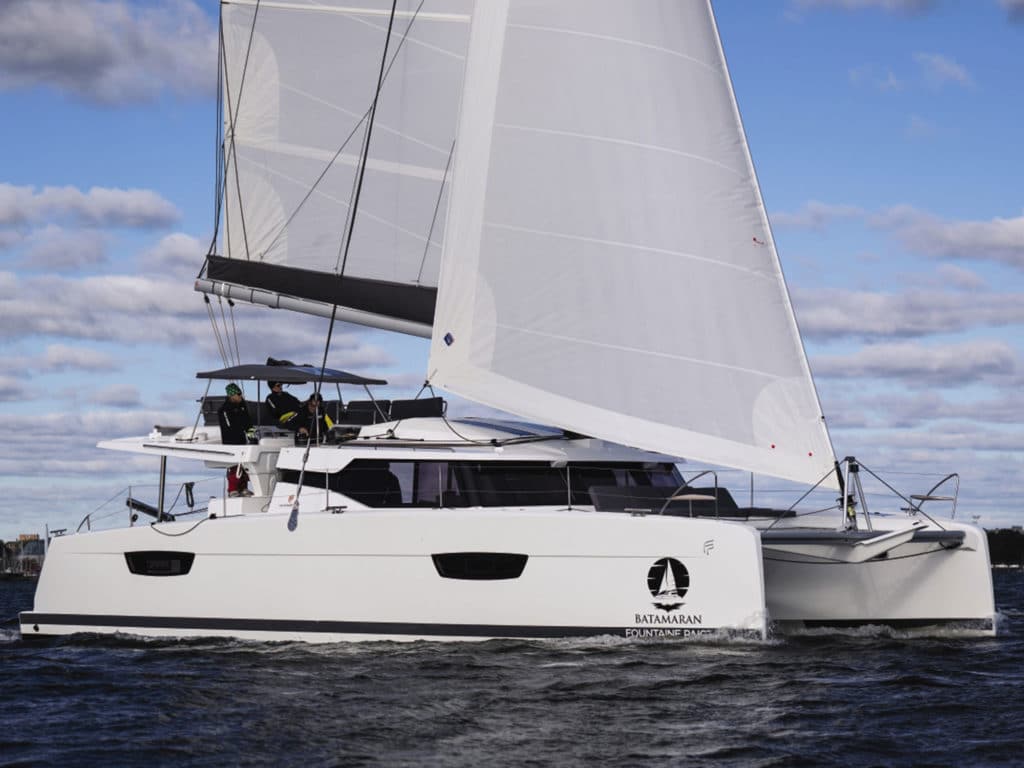
When it came time to replace its popular Helia 44, Fountaine Pajot asked customers what they wanted in a midsize cruising catamaran, and then turned to naval architect Olivier Racoupeau and its in-house team to design it. The result is the Elba 45, a stylish-looking cat with slightly inverted bows, a reverse sheer to its hulls, and a sporty coachroof and Bimini that does double duty as a flybridge lounge.
The Elba made its North American debut this past fall at the U.S. Sailboat Show in Annapolis, Maryland, where our Boat of the Year judges and I first inspected its construction, layout and systems dockside, and then a few days later, took it sailing on a picture-perfect morning on Chesapeake Bay.
In breeze that wavered between 12 and 16 knots, the Elba turned in a respectable 6.4 knots close-hauled and a little better than 7 knots on a beam reach under genoa and flattop mainsail. We quickly found the Elba to be an easy boat to sail, which is just one of the reasons that at week’s end the judges awarded it the title of Best Charter Boat for 2020.
Like most of the company’s models, the Elba is available in an owner-preferred three-cabin Maestro version and a four-cabin charter layout, which was the boat we sailed.
In the Maestro, the owner gets the entire port hull, with a queen berth aft, a desk/vanity and storage lockers amidships, and a spacious head area forward that includes a walk-in shower located outboard and separated by a sole-to-ceiling wall of glass. It’s a neat arrangement. The starboard hull is laid out with double guest cabins fore and aft, each with its own en suite head and separate shower. For charter, the starboard-hull layout is mirrored to port, so everyone’s accommodations are pretty much equal.
In either version, the saloon is the same, and a bright and roomy place to spend time. A large sliding door aft lets living space spill into the cockpit, where a dining table and ample relaxation stations are located. Indoors, visibility in all directions is excellent, thanks to oversize windows; the center one forward opens outward to let in the breeze. Seated on the aft-facing U-shaped couch (one side is actually more like a daybed, and it turns into a lounge chair with a tablet docking station adjacent), I liked the pair of skylights overhead that provide a clear view of the sails, and the low coffee table close by.
RELATED: Fountaine Pajot Elba 45: 2020 Boat of the Year Best Charter Boat
Missing from the layout is a traditional nav station—customers said they don’t use them. Instead, there’s additional galley and storage space, and the ability to hook up a laptop to a flat-screen display at the entrance to the saloon. Also missing was an interior dining table (it’s available as an option).
While flybridges are the rage in charter-boat design these days, for passagemaking they are not so practical because the helmsman is exposed to the elements and isolated from the crew down below; and design-wise, the boom has to be that much higher off the water. FP has found what I think is a practical solution by placing the helm station to starboard, halfway in between the lounging area atop the Bimini and the cockpit below.
The Elba also features what I’d call a split-helm arrangement, with a pass-through between the steering-wheel pedestal and the three winches mounted forward on the cabin top. Singlehanding, the skipper can engage the autopilot to free up both hands, or step around the wheel but still keep a hand on it while trimming sails. With crew, the sail trimmer gets their own workstation with plenty of elbowroom for maneuvering. Our judging team liked this arrangement. But they also thought a more robust traveler would benefit the boat.
Under power, a pair of 60 hp Volvo diesels with saildrives (50 hp is standard) pushed the Elba right along at about 8 knots at cruising rpm and better than 9 knots in get-there-quick mode. I’d guess with just a little more breeze, we’d have seen similar speeds under sail. As fit out, the boat we sailed had a sticker price of just over $800,000. BOTY judge Ed Sherman often notes that the noise levels while motoring are an indication of how well a boat is built, and hence its value. “This was one of the quieter boats that we’ve tested,” he said of the Elba’s reading of 72 dB with the throttles wide open—”which is pretty much excellent.”
Amen to that.
Mark Pillsbury is CW’s editor.








